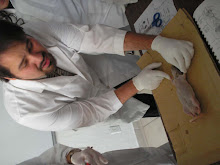Also, we saw of vaccines. A way of protections against viral diseases, it basically involves applying the virus itself so that the immunological system can prepare itself and be capable of protecting the body from future attacks. There are three types of vaccines. One involves just letting in pieces of the virus. Other involves inserting an inactive virus. And the last, involves inserting a virus, that though it can still act, it's been weakened to minimize problems.
Finished with that, we moved into bacteria. Bacteria compose two of the three domains of classified organisms: Eubacteria and Archaeobacteria. The Archaeobacteria are composed of the primitive bacteria, who had been living longer than the rest of the organisms. This is due to being able to survive in the extreme conditions the Earth was all those years ago. Mainly, there are the thermophyles, who live in very hot places; acydophyles, who live in very acid places; methanogenic, who live in places with lack of oxygen; and halophyles, who live in very salty places. Fortunetly, since they can't adapt to conditions not as extreme, it's guaranteed they can't really do much outside of them, which means that if they were the source of deseases, they can't affect other living organisms since or else they die before having the chance. So, archaeobacteria are harmless, or rather, aren't able to harm us in any way if they could.
The Eubacteria are more recent, and also the most common kind of bacteria. These can cause diseases on other living organisms. There are many of these. The structure of a bacteria is, being a cell basically, that of DNA covered in citoplasm, and also contains ribosomes. Like plant cells, they have a cell wall, and for movement they contain flagellum to do the task. One fact of bacteria is that if they ever find themselves low on resoursces, they would cut their flagellum, cover themselves with an extra outer cover called Endospore, and basically, go into 'hibernate', so to speak. They won't 'wake up' until conditions and resources return to normal. How long they can last like this is not entirely sure. But, there has been bacteria like this found in the ancient Egyptian pyramids that were able to 'revive'. Which means they are capable of lasting for a few thousand years at most.
Last, we saw a few differences between the two groups. First, eurobacteria have clycerol and fatty acids in the membrane. Their wall have proteins and carbs, while their RNA is unique in itself. On the other hand, archaeobacteria have glycerol and hydrocarbons in the membrane, glycoproteins in their wall, and their RNA is eukaryote-like.
Juan Manuel Aguirre

No hay comentarios:
Publicar un comentario